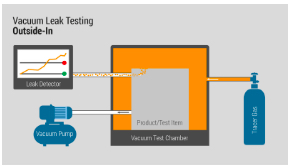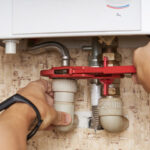The Importance of Leak Detection
 Many people are unaware of a leak in their home until they see pools of water on the floor or smell musty odors from mold and mildew. It is important to detect leaks as quickly as possible.
Many people are unaware of a leak in their home until they see pools of water on the floor or smell musty odors from mold and mildew. It is important to detect leaks as quickly as possible.
The best way to check for a leak is to read your water meter after shutting off all faucets and waiting one hour. If the dials have moved, a leak exists. Click Me for more details.
Leak detection systems help protect the environment from a host of issues caused by pipeline failures. These include gas spills, water leaking into the ground, sinkholes, and other environmental damage. They also save money by preventing the unnecessary loss of materials and resources.
There are many different types of leak detection systems, and they are categorized into two classes: static and dynamic. Static leak detection systems use a single device to locate and identify a pipeline leak, while dynamic leak detection systems continuously monitor the integrity of a pipe network (Cataldo et al. 2014). These systems are typically installed in high-risk areas such as oil refineries and chemical plants, which means that they must be able to operate in extreme conditions.
Aside from protecting the environment, a major benefit of pipeline leak detection is saving resources and money. Even a small amount of product loss can dramatically affect profits, which is why leak detection systems are important for oil and water companies. Early identification of leaks can prevent costly and hazardous situations such as massive gas spills or water seeping into the ground along highways and causing sinkholes.
In addition, implementing leak detection can help reduce costs for homeowner associations that pay for water, sewer, and waste management services for multi-dwelling property residents. The installation of leak detection systems can result in reduced water use, which can lead to significant savings for HOAs and property owners.
Some of the most common methods for locating a leak include visual inspections, odor, or sound. Biological methods utilize experienced personnel or trained dogs to walk along pipelines, looking for unusual patterns, smelling chemicals that may be released from the pipeline, or listening to sounds that could be generated by escaping products. These traditional methods can be time-consuming and prone to errors.
Other, more advanced leak detection techniques use sensors to measure the vibrations that are caused by fluid pressure changes in the pipes. These sensors can identify the location of the leak and send a signal to a technician for repair. Many of these systems are programmable, which allows them to monitor specific parameters and detect a change in those parameters when a leak is present.
Economical
The water lost through leaking pipes is not only an environmental concern, but it also results in real losses for the utility company. Leak detection is one of the best ways to reduce non-revenue water (NRW), which includes water that is treated and pressurized but not delivered for its intended use. The utility industry estimates that NRW accounts for about 20 percent of all treated water losses.
Modern leak detection systems can pinpoint the location of a leak in a pipe, which enables the utility company to repair the line with minimal cost. Most of these systems are non-destructive, so the property is left in the same condition as it was prior to work starting. This saves on the cost of digging up and replacing old or damaged pipes.
For residential homes, leak detection is a crucial part of ensuring the safety and reliability of household plumbing. Many leaks go undetected, which can result in costly damage to appliances and other equipment in the home. Whether a homeowner has old or corroded metal plumbing or is worried about acidic water conditions that can deteriorate galvanized steel, leak detection can help ensure small leaks don’t turn into jaw-dropping repair bills.
The most commonly used methods of leak detection include acoustic and tracer gas technologies, with the latter using unique substances to detect water or other liquids. The earliest research on the subject utilized tracers such as carbon dioxide and hydrogen, while later research has developed a variety of vibration measurement sensors and ground-penetrating radar technology (Brennan et al., 2012).
Another method of evaluating the effectiveness of leak detection systems is by measuring the risk reduction that occurs with and without the system in place. This can help utilities justify changes to leak detection systems and compare them to other infrastructure investments.
Regardless of the type of leak detection system used, all are designed to provide an early warning that a pipe is about to fail. This allows utility companies to repair the leak before it causes significant problems for customers. Water leaking from a failing main or from a broken sprinkler head can cause structural damage to the home as well as lead to flooding and other problems. The EPA notes that a well-designed leak detection and repair program can help prevent these issues.
Safety
In the industrial world, leak detection helps to protect workers and the environment from dangerous conditions. Many processes involve the transportation and storage of gases, liquids, and other materials that can cause harm if they leak or spill. Leak detection systems can monitor the movement of these substances and alert personnel when there is a problem. This can help prevent hazardous conditions such as fires, explosions, and environmental contamination.
In some cases, leak detection can also save money. Unaddressed leaks in industrial settings can lead to expensive repairs and downtime. This can lead to lost revenue and reduced productivity. However, with advanced leak detection technology, companies can keep their equipment and products running without the risk of leaking materials.
Another way that leak detection can save money is by preventing waste. For example, water leaks in homes can result in thousands of dollars in wasted water per year. Luckily, modern leak detection can prevent this from happening by detecting the presence of water leaks early.
These systems can be programmable and will shut off your home’s water supply when they detect unusual water flow. Additionally, they can connect to your smartphone via an app and send you an alert when your water usage patterns change. This can save you a lot of money and protect your property even when you are away from home, such as on vacation.
Leak detection can also help save energy. When pipes are leaking, it is important to shut them off as soon as possible in order to minimize energy loss. However, this can be difficult if you don’t know where the leak is located. Using leak detection, you can be sure that the problem is fixed as quickly as possible and will not have an impact on your energy bill.
In the industrial world, leak detection is essential for keeping factories running smoothly and efficiently. Pipes carry a number of vital materials, and any leaks or ruptures can be disastrous. Using leak detection, these facilities can make sure that all their materials are safely stored and transported, which will lead to increased production and profits.
Reliability
The reliability of a system is the amount of time that it will operate without failure. It is determined by calculating the mean operating time divided by the standard deviation of the system. A utility that has a system with low reliability will experience significant amounts of waste and loss of service. In addition, the system will require frequent repairs and replacements. This can result in a significant cost to the utility and can affect customer satisfaction. The utility can mitigate these issues by conducting leak detection on a regular basis and isolating leaks as they occur.
Leaks can result from a wide variety of causes and are extremely difficult to find. Fortunately, modern leak detection technology can identify a leak and determine its location without the costs associated with digging up properties. This saves the utility time and money while providing customers with confidence that their leak will be repaired quickly and efficiently.
The most effective way to reduce water loss is through early leak detection. Over time, a small leak can grow into a major rupture and cause costly damage and disruption to the community. In the United States, over two trillion gallons of water are lost each year due to leaks within existing infrastructure.
Detecting these leaks is critical to avoiding major disasters. Early detection and repair can significantly reduce water losses, protect the environment, save energy, and prevent costly infrastructure repairs.
In a typical pipeline system, there are numerous sensors to monitor the operation and condition of the pipes. Sensors can include flow, acoustic, and rate-of-change devices that monitor the water or gas in a pipe network. Using these sensors and utilizing a data management platform can allow the utility to identify potential problems in advance of a rupture.
Acoustic sensors are the most popular and cost-effective method to locate pipeline leaks. These devices are designed to monitor and record sounds emitted from the pipeline, including background noises such as pedestrian footsteps and passing cars. The sensors can also be used to detect acoustic anomalies, such as a bubble or hissing sound indicative of a leak.

